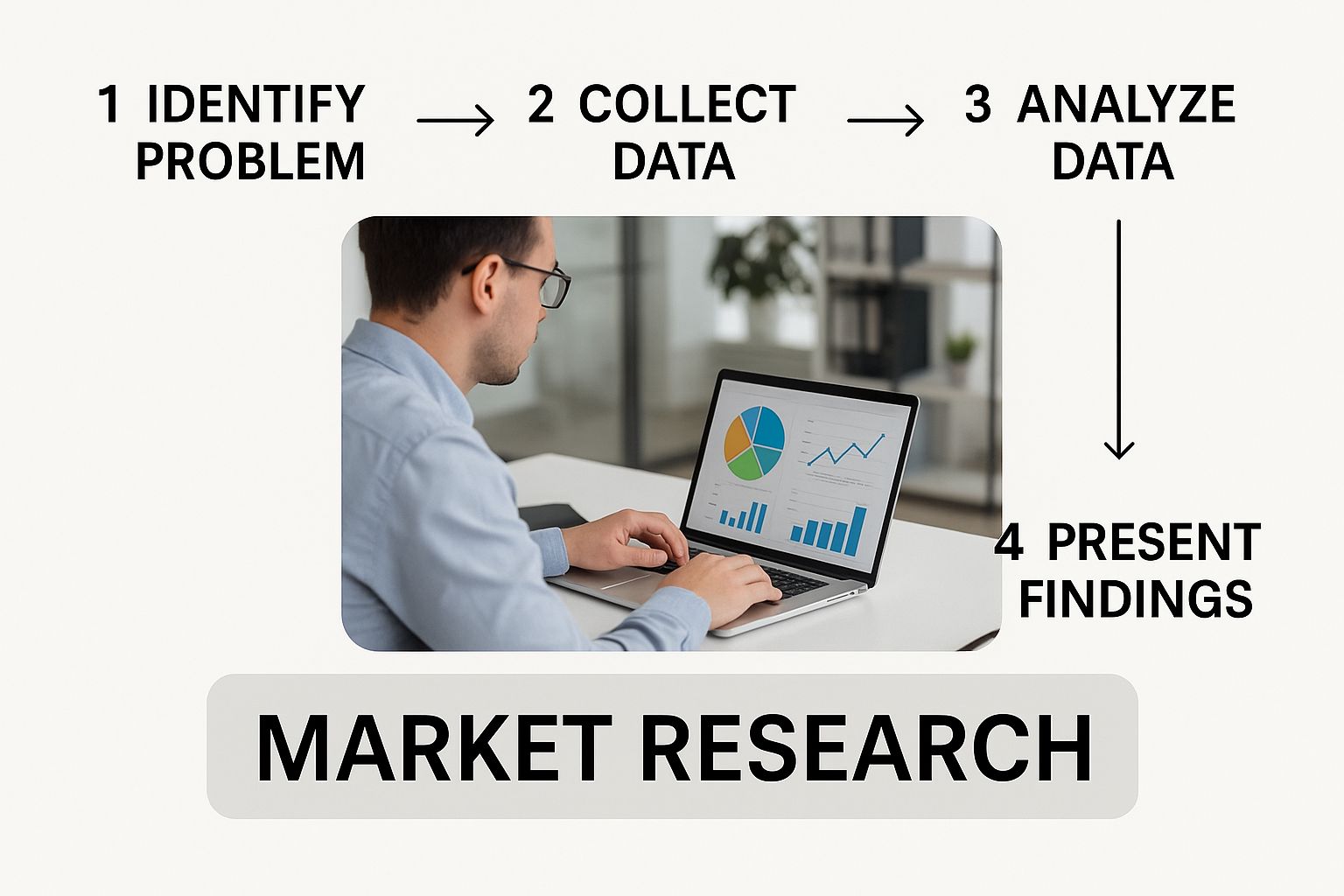How to Create Buyer Personas That Drive Growth

How to Create Buyer Personas: Crafting detailed, research-backed buyer personas is the bedrock of any solid marketing strategy.
It’s about getting beyond guesswork and digging into real data about your ideal customers—understanding their goals, their headaches, and turning that insight into a profile you can actually use.
Why Generic Personas Are Costing Your Business
Let’s be honest, the textbook definitions are a bit dry. In a market this competitive, vague, assumption-based personas aren’t just unhelpful; they’re actively burning a hole in your budget and stalling your growth. Relying on guesswork is like driving with a blindfold on—you’re moving, sure, but almost certainly in the wrong direction.
So many businesses fall into the trap of creating what I call “vanity personas.” These are the profiles filled with fluffy details like “Marketing Mary loves coffee and is active on LinkedIn.” While probably true, that tells you absolutely nothing of strategic value. It doesn’t tell you why Mary needs your software, what keeps her up at night professionally, or what proof she needs to see before she’ll even consider a purchase.
The True Price of Assumptions
When your personas are built on flimsy foundations, every single marketing action you take is weakened. Your ad copy feels generic, your content doesn’t hit on real pain points, and your product development can completely miss the mark. This all translates directly into wasted ad spend, a pipeline full of low-quality leads, and dismal conversion rates. You end up attracting the wrong crowd, who then chew up your sales team’s time and resources without ever signing on the dotted line.
The real problem with generic personas is that they lead to generic marketing. In today’s crowded digital space, generic is invisible. Your message gets drowned out because it isn’t speaking directly to anyone’s specific needs or ambitions.
This isn’t just a hunch; the numbers back it up. Research shows that in the UK, a whopping 71% of companies that beat their lead generation and revenue targets have documented buyer personas. An even more staggering 93% of those successful companies segment their database by persona. It’s clear that the top performers prioritise tailoring content by persona, a far more powerful strategy than just slicing by industry or location.
How to Create Buyer Personas: From Wasted Spend to Strategic Investment
Making the shift from vague profiles to data-driven personas changes the game entirely. It turns your marketing from a cost centre into a strategic investment. Every pound you put into advertising becomes more efficient because you’re targeting people whose problems you can genuinely solve.
This clarity also helps with bigger decisions, like resource allocation and knowing when to call in specialist support. Having a firm grip on the costs and benefits gives you the context needed to evaluate the value of targeted campaigns, a key factor when you’re looking into the pricing of a PPC agency.
When you truly understand your audience, you kickstart a powerful feedback loop:
- Better Targeting: Your ads finally reach people who are actually looking for what you offer.
- Higher Engagement: Your content resonates because it speaks to specific challenges and goals.
- Increased Conversions: Your landing pages and offers align perfectly with what the user wants, driving more action.
- Improved ROI: Your marketing budget starts working a lot harder, delivering real, measurable business growth.
Ultimately, investing the time to create proper buyer personas isn’t some “nice-to-have” item on a to-do list. For any UK business that’s serious about achieving sustainable growth, it’s a fundamental strategic move.
Gathering Your Data Without Guesswork
Right, let’s be honest. Strong buyer personas aren’t built on wishful thinking or vague assumptions about who you think your customer is. If you want results, you need to put on your detective hat. It’s all about gathering real evidence from different places to piece together an accurate picture of your ideal customer.
The best insights come from mixing two types of information: what people do and what they say. When you blend hard data with human stories, you get the full picture.
The image below gives a great overview of the kind of data streams you should be tapping into.

Think of it this way: one type of data gives you the skeleton, the other adds the flesh and personality. You need both to bring your personas to life.
How to Create Buyer Personas? Start with Your Internal Goldmines
Before you even think about looking externally, start with the goldmine of data you’re already sitting on. Your own business systems hold a huge amount of behavioural information that shows who your best customers are and how they found you.
Your Customer Relationship Management (CRM) system is the obvious first stop. Dig into the data and look for common threads among your most profitable or loyal clients. What patterns can you spot?
- Company Size: Are you mostly attracting small businesses or large corporations?
- Industry: Do your best customers tend to come from specific sectors like tech, retail, or construction?
- Job Titles: Who is the actual person you’re usually talking to? Is it a CEO, a marketing manager, or someone in procurement?
- Lead Source: How did these brilliant customers find you in the first place?
Once you’ve squeezed your CRM for insights, jump into Google Analytics. Don’t just glance at the top-level traffic numbers. You need to get it properly configured to track user journeys that actually mean something to your business. Set up conversion goals to see the exact paths people take before they get in touch or buy something. Which service pages or blog posts are they spending the most time on? This tells you what they genuinely care about.
Tapping into your internal data first is the most efficient way to ground your personas in reality. It provides a quantitative backbone that you can then flesh out with qualitative insights.
Uncover Insights from the Front Line
Your data tells you what happened, but it rarely tells you why. For that, you need to talk to your people. Your sales and customer support teams are on the front line every single day, having real conversations with prospects and customers. Their knowledge is pure gold.
Set aside some time for an informal chat with them. Don’t make it a rigid interrogation; just ask a few open-ended questions and let them talk. Try questions like:
- What are the most common objections you hear on a sales call?
- What’s that “aha!” moment when a prospect’s eyes light up and they “get” what we do?
- Which features or aspects of our service do customers rave about?
- What are the most common frustrations or problems you help customers solve?
The answers will give you a direct line into the real-world pain points, motivations, and desires of your audience. This is vital, especially when creating buyer personas in the UK, as it requires that perfect blend of hard data and human insight. The most successful businesses here supplement their analytics with real interviews and surveys.
This is critical because nearly 70% of the buyer’s journey is now done independently before a customer even thinks about speaking to a salesperson. To learn more about this, check out these great insights on the UK buyer’s journey on the-escape.co.uk.
Turning Raw Data Into a Compelling Persona Story

Let’s be honest, raw data is just a pile of facts and numbers. Spreadsheets don’t inspire great ad copy. The real work—and the real value—begins when you start to weave that research into a coherent story. This is where you transform survey results and analytics into a living, breathing profile of your ideal customer.
Forget those generic, fill-in-the-blanks templates. The goal here is to create something genuinely useful that your marketing, sales, and even product development teams can get behind. You’re looking for the common threads running through all your data and pulling them together to build a profile with some real depth.
Building the Persona Profile (How to Create Buyer Personas)
First things first, start clustering your findings. Look for similar answers from your interviews, spot the trends in your analytics data, and pay close attention to the patterns in feedback from your sales team. This process is less about ticking boxes and more about seeing the bigger picture emerge.
Every solid persona needs a few key components:
- Demographics: Go beyond just age and job title. Think about company size, industry, and maybe even their career path.
- Goals: What are they actually trying to achieve in their job? What does a successful quarter look like for them?
- Core Challenges: What are the biggest headaches and obstacles they face? These are the problems your product or service should be solving.
- Communication Preferences: Do they live in their inbox, prefer a quick video call, or need formal, detailed reports? This tells you how to reach them effectively.
This isn’t just admin work; it’s a deeply strategic exercise. When you truly understand these elements, you can shape everything from your ad copy to your product roadmap. This level of focus is a cornerstone of powerful marketing, especially for online retailers. In fact, many successful brands explore data-driven PPC strategies for ecommerce to sharpen their competitive edge by knowing their audience inside and out.
A great persona feels like a real person because it’s built on real stories. Don’t just list bullet points—craft a narrative. Write a short paragraph that brings their personality, motivations, and daily struggles to life.
Crafting a Day in Their Life
To make your persona truly hit home for your team, map out a ‘day-in-the-life’ scenario. This simple narrative builds empathy and helps everyone understand the real-world context behind your customer’s decisions. What’s their morning routine? What meetings are they constantly in? What tasks create the most friction in their day?
Finally, pinpoint their ‘watering holes’. These are the specific places—blogs, podcasts, industry forums, LinkedIn groups—where they go for information and to connect with their peers. Knowing exactly where your persona hangs out online is gold dust. It allows you to place your message right where it will be seen and heard, making your outreach efforts far more effective.
Right, you’ve drafted your buyer personas. That’s a solid first step, but don’t go archiving them just yet. Think of your personas as living, breathing hypotheses about your audience, not dusty files on a server. They need to be pressure-tested in the real world.
If you skip this part, you’re essentially gambling your entire marketing strategy on some well-researched, but ultimately unproven, assumptions. It’s a risky game to play.
Get an Internal Reality Check
First things first, run your draft personas by the people who talk to your customers every single day: your sales and customer support teams. They are your front-line intelligence.
Show them “Marketing Mary” and ask point-blank, “Does this person sound real? Is this who you’re actually talking to on calls? Are these the problems they bring up?” Their gut reactions and real-life stories are pure gold for spotting any gaps between your research and the reality on the ground.
Take It to the Source: Your Customers
How to Create Buyer Personas: Once your personas have passed the internal sniff test, it’s time for the ultimate validation: asking your actual customers. You don’t need to organise a massive focus group for this. Just pick out a handful of trusted, long-term clients who fit the profile you’ve built.
Share a simplified version of the persona with them. You could frame it as, “We’re working on understanding our customers like you better. Does this profile resonate with your role and the challenges you face?” The feedback they give you—the corrections, the additions—is priceless. It’s the kind of direct insight you simply can’t get from staring at data.
A persona isn’t truly finished until it’s been validated by the very people it’s meant to represent. This iterative process of feedback and refinement is what separates a useful strategic tool from a simple document.
When to Hit Refresh on Your Personas
Markets change, tech evolves, and customer habits shift. Your personas need to keep up, or your marketing will fall flat. Staying current isn’t just a good idea; it’s non-negotiable for staying ahead.
In fact, a whopping 65% of successful companies make a point to refresh their buyer personas at least every six months. It’s how they keep their campaigns sharp and on-point. On the flip side, a major pitfall for struggling businesses is failing to map out the entire buying committee—something 70% of companies that miss their goals are guilty of. You can dig into more stats on this over at tomislavhorvat.com.
Keep an eye out for these tell-tale signs that it’s time for an update:
- Campaigns Aren’t Hitting Like They Used To: If your once-killer ad copy is suddenly met with silence, it could mean your persona’s pain points have evolved.
- The Market Is Shifting: New regulations, technologies, or economic wobbles can completely change your customers’ priorities overnight.
- You’re Noticing New Behaviours: Are you getting different questions on sales calls? Seeing new user journeys on your site? These are clues.
Treating your personas as part of a continuous loop—create, validate, refine, repeat—is the secret to ensuring your marketing is always perfectly aligned with the people you’re trying to reach.
Using Personas to Sharpen Your PPC Campaigns

Right, you’ve done the hard work of building out your buyer personas. Now for the satisfying part: putting them to work where they can make a real difference to your bottom line – your pay-per-click (PPC) campaigns.
This is where all that research pays off. A well-crafted persona is the secret weapon for building smarter, more efficient campaigns that stop wasting your budget and start driving genuine conversions. We’re moving way beyond basic demographic targeting here. It’s about letting those persona insights guide every single decision, from the keywords you bid on to the copy on your landing pages.
Crafting Ad Copy That Actually Connects
Let’s be honest, generic ad copy is just background noise. Your personas give you the inside scoop you need to write ads that speak directly to an individual’s specific problems and what truly motivates them.
Imagine you’re selling project management software. You wouldn’t use the same message for everyone. Your approach would need to be different for each persona:
- For “IT Manager Ian”: You’d want your ad copy to scream security, seamless integration, and data compliance. Ian’s main concerns are the technical nuts and bolts and avoiding any potential risks.
- For “Marketing Director Mary”: Her focus is completely different. Your copy should highlight collaboration features, campaign tracking, and, most importantly, demonstrating ROI to the higher-ups. She cares about team efficiency and measurable results.
It’s the same product, but the messaging is poles apart. This is the kind of nuanced approach that turns a casual click into a solid conversion.
When your ad copy mirrors a persona’s language, priorities, and pain points, it creates an instant connection. Your ad suddenly feels relevant and stands out from a sea of generic competitors.
Sharpening Your Keyword Strategy and Landing Pages
Your persona research doesn’t just tell you what to say; it reveals how your audience actually searches online. Ian might be typing “secure project management software API” into Google, while Mary is looking for “best marketing team collaboration tools.”
These personas help you build out distinct keyword lists that capture these different search intents, allowing you to create laser-focused ad groups.
Of course, this level of personalisation has to carry through to your landing pages. Ian’s landing page needs to be packed with technical specs and case studies from other IT departments. Mary’s page, on the other hand, should feature testimonials from other marketing directors and visuals that show off streamlined workflows.
This isn’t just good practice; it’s what customers now expect. Research shows that 75% of consumers expect personalised website experiences, and a whopping 66% want tailored messaging. Your personas are the foundation for delivering exactly that. You can get more insights on this from a UK sales report by Salesforce.
How to Create Buyer Personas: Optimising for Higher Conversion Rates
When your ad copy, keywords, and landing pages are all perfectly aligned with a specific persona, the results really do speak for themselves. You’ll see your click-through rates (CTRs) climb, your Quality Scores improve, and – the metric that matters most – you’ll get more conversions.
This strategic alignment is a core principle of successful paid advertising. If you’re looking for more ways to get your campaigns firing on all cylinders, you might find our guide on how to improve Google Ads performance useful.
By applying these persona insights, you transform your PPC efforts from a scattergun approach into a precision tool, ensuring every penny of your budget is spent attracting your most valuable customers.
Answering Your Buyer Persona Questions
Even with a clear process laid out, a few common questions always seem to crop up when businesses start building out their buyer personas. Let’s tackle some of the most frequent hurdles head-on, so you can move forward with confidence and actually get some value from your hard work.
Getting these details right is absolutely crucial. It’s the difference between a persona that just sits in a shared folder and one that actively shapes your entire strategy, especially when it comes to paid ads. Knowing these nuances is exactly how a PPC agency focused on lead generation can build campaigns that genuinely deliver results.
How Many Personas Do I Actually Need?
This is the big one, and the answer is refreshingly simple: start with what you can realistically manage. There’s a popular myth that you need a huge library of personas to cover every single potential customer. That’s just not true.
For most businesses, starting with one to three well-researched personas is far more effective than having ten vague ones. Focus on your most profitable or most common customer types first. You can always build more later as you grow and your customer base gets more diverse. Quality over quantity is the golden rule here.
What If I Have a Small Budget or Customer Base?
Creating buyer personas isn’t some exclusive club for massive corporations with huge marketing departments. If you have a tight budget or a small pool of customers to draw from, you just need to be a bit more resourceful.
First, lean heavily on your internal resources:
- Talk to your founder or top salesperson: They hold a goldmine of information about who your first customers were and exactly why they chose you.
- Analyse your early sales data: Look for any common threads, no matter how small they seem.
- Use social listening: Monitor discussions in relevant online groups or forums. This helps you understand the language and pain points of your target audience, even if they aren’t your customers yet.
You don’t need expensive tools, just a willingness to do some digging. Even a few in-depth chats with your first handful of clients can give you more than enough insight to build a solid foundational persona.
A single, detailed conversation with a real customer is infinitely more valuable than a hundred assumptions made in a boardroom. Don’t let a small scale stop you from starting.
How to Create Buyer Personas: How Do I Get Buy-In from Other Departments?
A persona is only useful if it’s actually used, and used consistently across the entire organisation. To stop your hard work from gathering digital dust, you need to get buy-in from other teams, particularly sales and product development.
The secret? Involve them from the very beginning. Don’t just show up and present them with a finished document. Instead, ask for their input during the research phase. When the sales team sees their own feedback reflected in “Marketing Mary’s” pain points, they’re far more likely to adopt and use that persona in their day-to-day.
Frame the personas not as a “marketing thing,” but as a shared tool for understanding the customer. Show each department how the personas will make their jobs easier—better leads for sales, clearer feature requests for product, and more effective support scripts for customer service. When everyone sees what’s in it for them, adoption becomes a natural next step.
Ready to turn those persona insights into high-performing campaigns? The expert team at PPC Geeks can help you build a data-driven strategy that speaks directly to your ideal customers, reduces wasted ad spend, and drives real growth. Find out how we can help at https://ppcgeeks.co.uk.
Author
Search Blog
Free PPC Audit
Subscribe to our Newsletter
The Voices of Our Success: Your Words, Our Pride
Don't just take our word for it. With over 100+ five-star reviews, we let our work-and our satisfied clients-speak for us.
"We have been working with PPC Geeks for around 6 months and have found Mark and the team to be very impressive. Having worked with a few companies in this and similar sectors, I rate PPC Geeks as the strongest I have come across. They have taken time to understand our business, our market and competitors and supported us to devise a strategy to generate business. I value the expertise Mark and his team provide and trust them to make the best recommendations for the long-term."
~ Just Go, Alasdair Anderson
